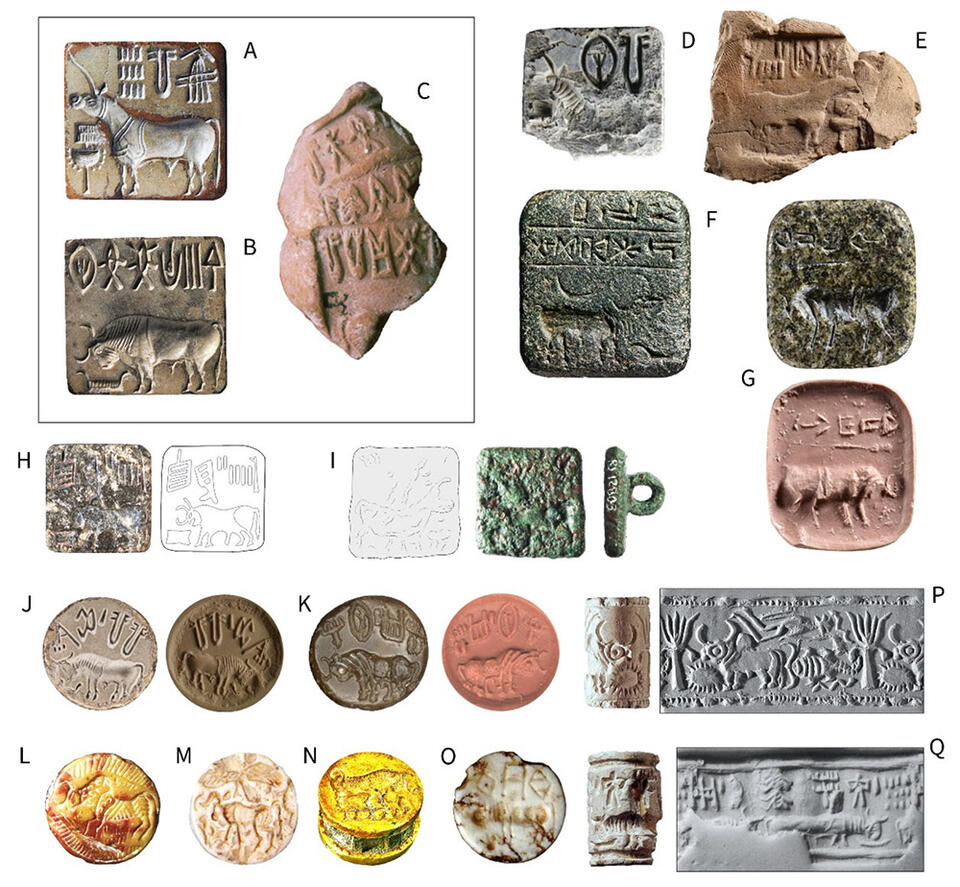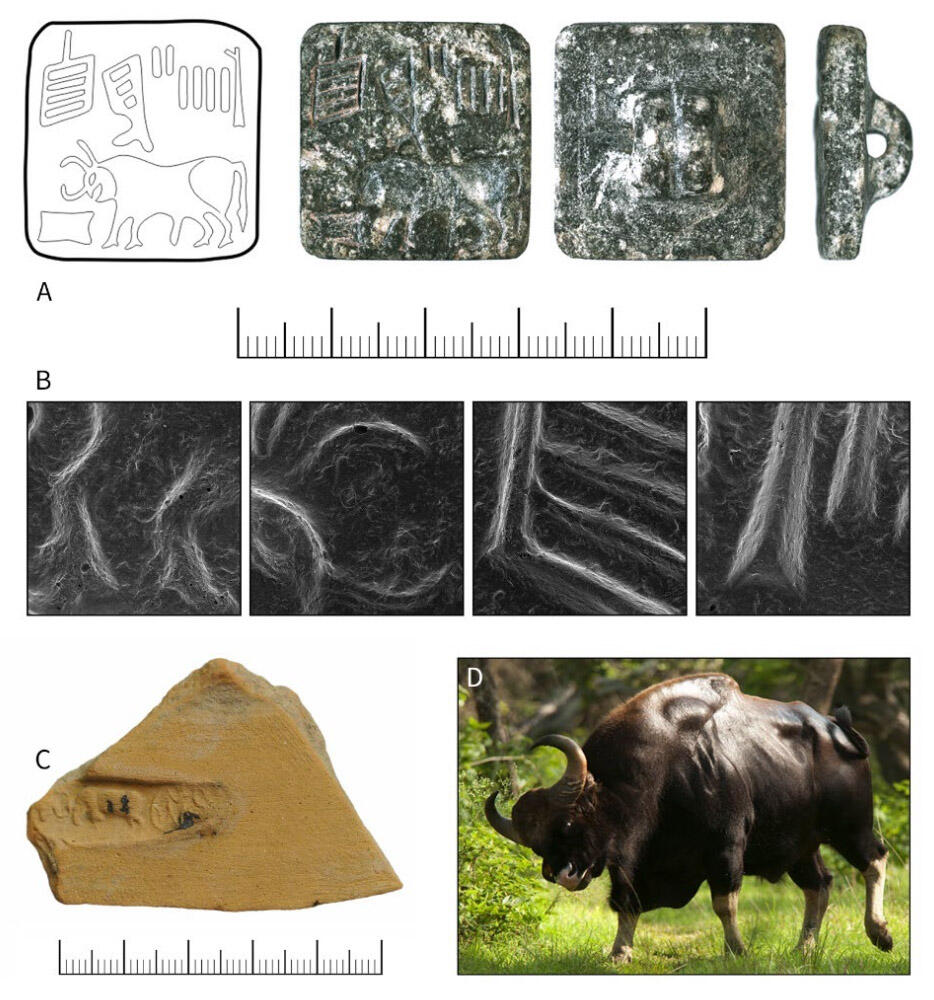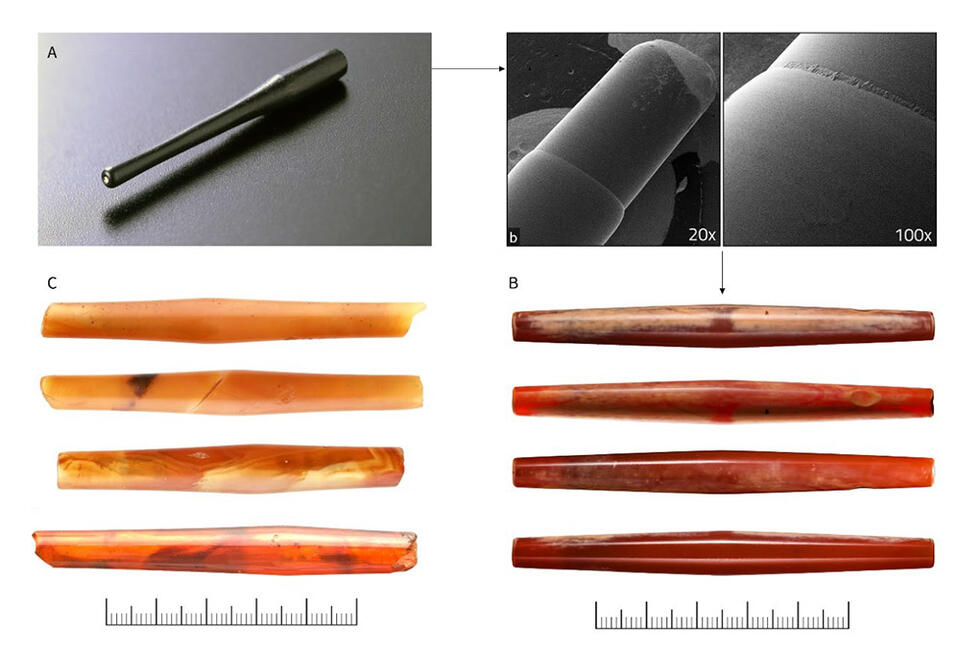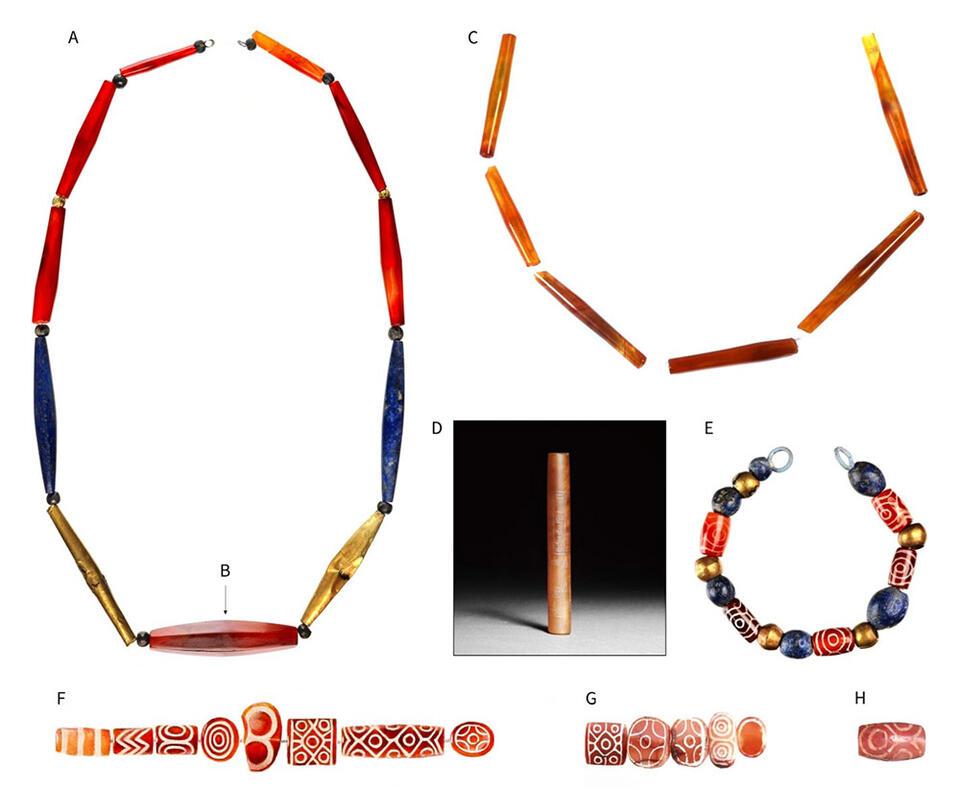A must-read paper for those fascinated by the extensive trade networks that the ancient Indus civilization was integrated with. Part of the Oxford Research Encyclopedias Asian History section, it is Infused with the latest research from the many regions in question. Forty pages summarize and delve into the evidence of people, texts, animals, minerals and plants to seals and weights, pottery, stone, metal and ivory objects, statues, games and toys and more. All the while, the author considers the bigger picture, what it says about the Bronze Age throughout Western and South Asia, and what he calls the Indus civilization's "global marketing strategy." (Might that be - lead with carnelian?)
"The Indus Civilization resulted, in fact, from a long process of coherent selection, assimilation, and eventual crystallization of cultural traits from different regional cultures spread over a vast and highly differentiated territory. The inclusion of these communities into an integrated sociopolitical, economic, and cultural superstructure took place in the centuries between c. 3300 and 2600/2500 BCE, which are also known as the Early Indus (or Harappan) Phase. During this formative period, there is discontinuous evidence for episodic or down-the-line commercial connections with southeastern Iran and southern Mesopotamia, while long-distance trade with Central Asia was already quite structured," writes Frenez (p. 4).
Here we discuss only a few of the many lines of thought and investigation that the author delves into. One is the infrastructure of trade, for which seals are probably the most resonant, sophisticated in manufacture, functional markers. They were the (slow-moving) trade internet of their times. Seals and people went together, and it may well be that the bison figure represented a trading class (see Images 1 and 2 above for examples of seal finds and the bison figure):
"In the last two centuries of the 3rd millennium BCE, a new Indus-related round seal type—the most famous regional variant of which are the so-called Gulf-type seals—seems to have been introduced to be exclusively used by Indus and Indus-related merchants active outside the Indus Valley (figure 3J-O). Almost 90 percent of these round stamp seals, which all account for just less than half (40 percent) of all Indus-related seals found outside the Indus Valley, bear the image of an Indian bison often rendered in the local art style. At the time of their first discovery at Ur and Susa, Cyril Gadd and Ernest Mackay independently suggested that they were typical of Indus sites that had not yet been explored. With the new discoveries in Bahrain, Mortimer Wheeler proposed instead that they may have been produced locally for the needs of a cosmopolitan trade.68 Indus-related round seals depicting an Indian bison with the head lowered were later found also in Fars and Central Asia. Wheeler’s hypothesis was confirmed by a detailed morphological study by Steffen Laursen, who defined four regional types with a solid internal consistency. In addition to their shape and proportions, the rendering of the Indian bison on the round seals differs slightly from that on the standard square seals, and the manger-like object is often replaced by enigmatic objects or creatures. This latter feature is also observed on several Indus-related cylinder and prismatic seals from Mesopotamia, Iran, and northeastern Arabia, reinforcing the evidence for their local production" (p. 7).
The emerging verdict from pottery finds in the northern Gulf is also interesting. Whereas there are only fragments thus far in areas where seals are richest, "a completely different picture emerged in southeastern Arabia, where Indus ceramics are not only very abundant but also produced locally. Indus black-slipped jars are ubiquitous at Umm an-Nar sites along the coast and in the interior. In addition to storage jars, Indus pottery also includes black-on-red painted jars and different containers used for food processing, presentation, and consumption, such as the characteristic Indus perforated jars, pedestalled dishes, cooking pots, and now also pointed-base goblets . . .. The abundance of Indus pottery in southeastern Arabia compared to the other regions linked with the Harappan external trade is not easy to explain. Considering the harsh environment of the region, overseas imports may have included amounts of staple commodities greater than those destined for regions with higher and more diversified food production" (p. 11).
There are detailed pages on the exciting and continuing discovery of Indus-style carnelian beads across the ancient world (see Images 3 and 4 above).
There is also an extensive bibliography, a detailed discussion, over 200 footnotes, and concluding reflections on some of the larger questions that tie Indus culture to our own in this invaluable chapter:
"Terms such as globalization and glocalization have recently been introduced and are increasingly utilized in the theoretical debate on premodern and ancient societies to describe transcultural interaction modes and their long-term socioeconomic and cultural outcomes. According to Serena Autiero and Matthew Cobb, in premodern societies, 'globalization is characterized by increasing connectivity that facilitates the movement of goods, people and ideas,' leading to 'profound changes in the various societies connected by these global networks economically, culturally, politically, psychologically.' The two authors continued by stating that, 'in the process, new forms, in terms of ideas, technologies and objects, could be generated.' Based on this definition, it is undeniable that the ecumene that encompassed the core of Eurasia—from the Greater Indus Valley to the Nile, and from southern Arabia to Central Asia—experienced globalization phenomena during the 3rd millennium BCE. What is more difficult to say is whether and how these processes were conscious attempts to create a “globalized” world or rather resulted from the unilateral, prototypical implementation of global marketing strategies with reflexes on the whole, interconnected system" (p. 24).
Image 1: A-C, Indus-type seals and clay sealings from the Greater Indus Valley, and D and E, from Umma (Iraq). F and G, Indus-type seals in chlorite with cuneiform inscriptions (Iraq). H and I, Indus-type seals from Oman respectively in chlorite and copper. J and K, Indus-related round seals with the image of an Indian bison from Ur (Iraq), and L–N, from Central Asia. O, Indus-related round seal with a Linear Elamite inscription. P and Q, Indus-related cylinder seals respectively from Ur (Iraq) and Susa (Iran).
For (A): Joshi and Parpola, Corpus of Indus Seals and Inscriptions, Vol. 1, 377, no. M-18.
For (B): Parpola et al., Corpus of Indus Seals and Inscriptions, Vol. 3.1, 371, no. M-236.
For (D): Hulínek and Hulínková Ťuchová, eds., Archaeological Project SAHI—Tell Jokha, 59, fig. 6.61.
For (L) Victor I. Sarianidi, Marguş: Ancient Oriental Kingdom in the Old Delta of the Murghab river (Aşgabat, Turkmenistan: Türkmendöwlethabarlary, 2002), 259.
For (M-O) Sylvia Winkelmann, Seals of the Oasis from the Ligabue Collection (Venice, Italy: Il Punto Edizioni, 2004), nos. I.4-01, I.4-02, II.1-02.
For (P-Q): Joan Aruz (ed.), Art of the First Cities: The Third Millennium B.C. From the Mediterranean to the Indus (New York, NY: The Metropolitan Museum of Art, 2003), 410–411, nos. 301a, 301c.
Source: (A) Courtesy of Archaeological Survey of India. (B) Courtesy of National Museum of India (C) Courtesy of Lothal Revisitation Project & Archaeological Survey of India. (D) Courtesy of Slovak Archaeological and Historical Institute. (E) Courtesy of Ashmolean Museum, Oxford. (F) Courtesy of Bibliothèque Nationale de France. (G, J-K, P) Courtesy of Trustees of the British Museum. (H-I) Courtesy of the Ministry of Heritage and Tourism, Sultanate of Oman. (L) Courtesy of Sarianidi. (M-O) Courtesy of Ligabue Foundation. (Q) Courtesy of Louvre Museum.
Image 2: A, Indus-type seal from Salut ST1 (Sultanate of Oman) featuring an Indian bison (or short-horned bull) with lowered head and a sequence of Indus writing signs, which was found to be made using the same carving technique applied in the Indus Valley (B). C, Fragment of a local Umm an-Nar jar from Salut ST1 stamped before firing with an Indus-inscribed tablet featuring two Indian bison in combat and Indus writing signs. D, Living specimen of Indian bison (Bos gaurus, Smith, 1827) in the same pose as it was represented on the Indus seals.
For (A, C): Frenez, “The Indus Civilization Trade with the Oman Peninsula” 394, figs. 35.12, 35.13. For (B): Frenez, et al., “Bronze Age Salut (ST1)” 116, fig. 9.
Source: (A, C) Courtesy of Ministry of Heritage and Tourism, Sultanate of Oman. (B) Courtesy of Kenoyer. (D) Courtesy of Zoological Survey of India.
Image 3: A, Indus-type constricted cylindrical drill in Ernestite from Dholavira (India). B, Views of an Indus-style long carnelian bead from Bat (Sultanate of Oman) with scanning electron microscope (SEM) images of an elastomer impression of its drillhole showing the characteristic highly polished perforation left by Indus constricted cylindrical drills (b). C, Different Indus-style long carnelian beads from Susa (Iran).
For (A): Hideo Kondo, Indus Civilization Exhibition (Tokyo, Japan: NHK Promotions, 2000), 107. No. 598.
For (B) Jonathan Mark Kenoyer and Dennys Frenez, “Carnelian and Agate Beads in the Oman Peninsula,” in In the Shadow of the Ancestors, eds. Frenez and Garba (2020), 408, fig. 36.21.
For (b) Kenoyer and Frenez, “Carnelian and Agate Beads in the Oman Peninsula” 408, fig. 36.23.
Source: (A) Courtesy of Archaeological Survey of India. (B) Courtesy of Ministry of Heritage and Tourism, Sultanate of Oman. (C) Courtesy of Louvre Museum. (b) Courtesy of Kenoyer.
Image 4: A, Necklace from the Royal Cemetery of Ur (Iraq) including Indus-style long carnelian beads and (B) a local- type faceted carnelian bead, all drilled using Indus-type constricted cylindrical drills. C, Necklace from Girsu (Iraq) composed of Indus-style long carnelian beads. D, Indus-style long carnelian bead with a dedication in cuneiform writing by Shulgi, second king of the Third Dynasty of Ur. Strings of beads including Indus-style bleached (etched) carnelian beads respectively from (E-F) Ur (Iraq), (G) Susa (Iran), and (H) Abydos (Egypt).
Source: (A, E) Courtesy of Penn Museum. (C, D, G) Courtesy of Louvre Museum. (F) Courtesy of Trustees of the British Museum. (H) Courtesy of Petrie Museum.








